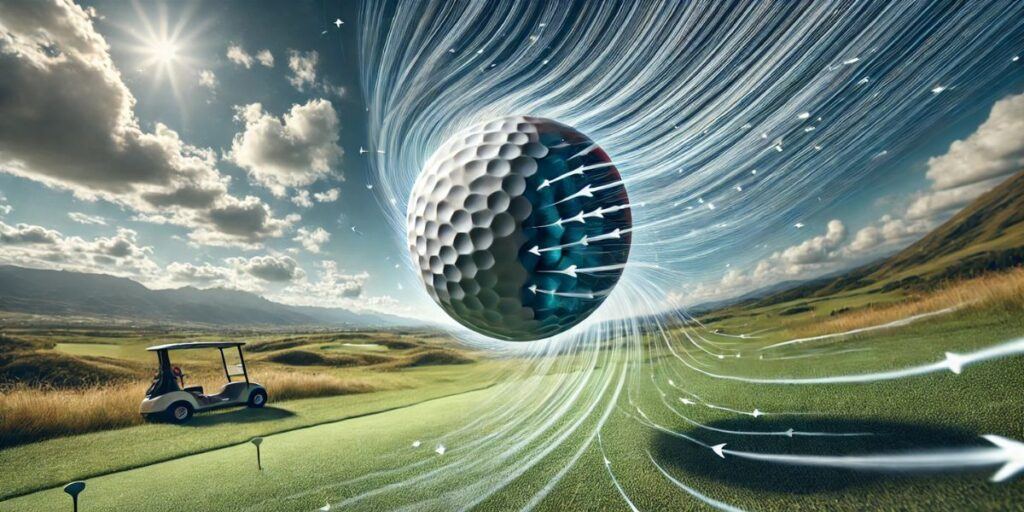Did you ever wonder what happens when you smack a golf ball? It is not just about hitting it as hard as possible. The moment that clubface meets the ball, a whole host of factors kick into play. Speed, direction, and spin are all part of the physics of golf ball Impact.
Faster swing speeds generally lead to greater distances, but it’s not just about power. The direction is where precision meets physics. The angle of impact steers the ball’s initial flight path. When you’re hitting with enough spin, the ball gets a lift and distance kick. That being said, let’s get deeper into the matter.
Kinematic and Dynamic Principles
Physics shapes every golf shot you make. Newton’s Laws of Motion help explain it. First off, let’s talk about why your ball takes off and where it’s headed. A ball at rest remains at rest until acted on. It’s the club’s force that gets it going. That is Newton’s First Law. Then, Newton’s Second Law explains how different forces, mainly gravity and friction, pull the ball down.
Torque and angular momentum have a lot to do with spin and swing. You want more torque for longer drives. Angular momentum helps the ball move on a nice flight trajectory. Then there are linear and rotational motion. Understanding the difference can help you figure out why the ball travels the way it does. Linear is all about straightforward travel, while rotational covers spins and curves. Master the two, and your golf game will look as clean as possible.
Granted, you do not have to learn all of this and know it by heart. However, it could help you understand and improve your game a bit. Then again, if you have a scientific approach to golf, have fun!
How a Golf Ball Deforms on Impact
What happens to a golf ball when it’s hit by a golf club? Here we talk about compression. When the club hits it, the golf ball gets squashed, albeit just for a moment. It is all about storing and then releasing the power.
The elastic properties of the ball are key. Most balls are designed to compress under certain forces. Precisely, this squishing action helps catapult it down the fairway. But just because it squeezes doesn’t mean it’s going to perform the same every time. The amount it compresses relates directly to how fast you’re swinging and the specific angle of impact.
Speed, angle, and the type of club used come into play here. Did you ever hit a ball and just felt like it didn’t go that far, even with a good swing? You might be struggling with the wrong type of ball. Either that or you are not getting the compression you need for your swing speed.
Why does all this matter? Well, understanding compression affects how far your ball will travel. Also, it affects how the ball will behave once in the air. Therefore, it is important you use the right golf ball suited for your game.

The Role of Aerodynamics in Ball Flight
Dimples have a crucial role related to aerodynamics in a ball flight. They revolutionize how the ball flies through the air. The dimples create a thin turbulent boundary layer of air that clings to the ball’s surface a bit longer. It reduces drag and allows the ball to cut through the air more smoothly.
The Magnus effect plays a starring role here, too. It’s all about how spin affects trajectory. When your ball’s spinning, it interacts with the airflow, generating lift. This helps the ball to fly higher and curve nicely if you are shaping your shots.
Altitude and weather conditions also have an impact. Air density changes with altitude and temperature. So, playing at different elevations or in varying climates can change how your ball cuts through the sky.
Understanding these dynamics helps you adjust your game. It is the difference between playing the same way every time and adapting to different conditions. Finally, it all leads to consistency and better performance.
Evolution of Golf Ball Composition
Golf balls have come a long way since the days of wooden clubs and featheries. Back in the day, a round object was stuffed with feathers—hence the name. Nowadays, science and technology have redefined what makes a golf ball efficient and reliable.
Modern golf balls are a complex blend of materials, each designed to maximize distance, control, or durability. The core is often made from rubber or a synthetic polymer. This helps compression while maintaining flexibility.
The cover is made from urethane or ionomer. Urethane covers provide excellent spin control for players who prefer distance control. Ionomer covers are tougher for golfers looking for durability most of all.
Understanding ball material can help tailor your game to specific needs. Want distance? There’s a ball for that. Need more control and feel? There’s one for that too. This understanding allows you to select a ball that matches your swing speed and playing style.
Optimizing Performance
Let’s put it this way. If you’ve been using just any ball, maybe it’s time to see how picking the right type can work in your favor.
First, evaluate your playing style. Whether you are going for distance or focusing on the short game, there is a ball that suits your needs. Analyze what aspects of your game can benefit from distance, control, or durability. Then, pick accordingly.
Furthermore, your playing technique can also make a big difference. Adjusting your swing to maximize ball compression can make a big difference. Also, adapting to different weather conditions can elevate your performance.
Finally, you should make sure your golf clubs are a perfect match for your style. Playing with the right equipment can be a huge boost on the course. Finding custom fitting experts might be the right way to do it. Just make sure they are independent so they can provide you with the best options.

A Lot of Details
As you can see, numerous details affect the golf ball’s physics on impact. Do not worry if you don’t learn every single little detail. What matters is that you know sometimes you can only do so much when hitting the ball. We all know there is no perfection in golf, right? So, next time you go out, just relax and enjoy the beautiful game.
Related
- Does More Dimples on a Golf Ball Mean More Distance?
- How High Altitude Affects Golf Balls – Golf Better
- How Humidity Affects Golf Ball Trajectory and Spin
- What Is Golf Ball Compression?

